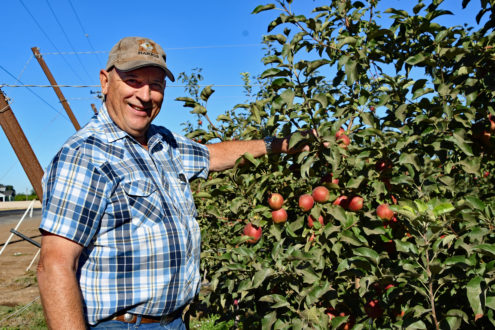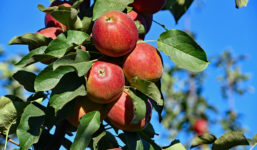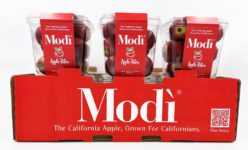
Oct 10, 2022Seeing red: Modì apple delivers colorful bounty in California
Like most of their California counterparts, Randy Rajkovich and his brother, David, struggled in the state’s Mediterranean climate to grow Gala and Fuji apples with the coveted red color.
“In California, we’ve never been able to raise a red apple just because of our heat later in the summer,” said Randy Rajkovich, who has been growing apples since 1988 in San Joaquin County, California. “All of the varieties we tried to grow here don’t get that all-over red color unless you use shade cloth, overhead sprinklers and reflective covering on the ground.

“Apple growers in our area still have a really bad taste in their mouths from growing Galas and Fujis. As soon as the Northwest would start picking, all of the buyers would say, ‘See ya California.’”
About nine years ago, Rajkovich received a phone call from a friend in the nursery business about a new club variety.
“He said he was in the middle of this apple orchard (in Spain) looking at different varieties, there was this one called Modì, it’s deep dark red and it’s 115 degrees,” Rajkovich said, recalling.
After researching the variety, the brothers secured a few trees and planted them near Stockton to see how they’d fare during California’s hot, sunny summers. They were sold on the Modì and each planted small acreage.
In addition to their own orchards, the Rajkoviches custom farm about 600 acres near Walnut Grove for JJB Family Farms, which holds the North American rights to the club variety.
California grown for Californians
Derrell Kelso, Modì Apple USA manager with JJB, said retail interest in the new variety has been strong and continues to grow. This year, the club variety will be in nearly 1,300 stores in California, including Kroger (Ralphs), Vons, Sprouts, Safeway Tracy and Save Mart/Lucky. He said he expected volume of about 40,000 40-pound cartons.
Kelso said they’re promoting the Modì as the “California apple grown for Californians, and a lot of the California retailers like to support California-grown product.”
Rather than shipping the variety to a few stores all over the country, he said they’re taking a targeted approach and saturating the market within the state. After all, Kelso pointed out, California alone has 40 million potential consumers.
“When you spend marketing dollars on TV ads or promotions on cooking shows, you get the most bang for the buck in that area,” he said of the focused approach.
The goal is to get consumers to try the new variety, and pricing is competitive with Fujis.
“If they eat (the Modì) and they like it, they’re going to keep buying it,” Kelso said.

In addition to loose fruit, the club variety is being offered in 2-pound bags and 3-pound clamshells of Modì Apple Bites — 138s or fruit about 2- to 2 1/4-inch diameter. Smaller fruit also goes into school lunch programs within California.
In addition, JJB is working with San Antonio-based H-E-B Grocery this season to trial larger sized 72s at 10 of its high-end Central Market stores.
All of the fruit decals, containers and point-of-sale materials have quick-response codes that take consumers to an educational video on the Modì USA website.
Based on projected volume, Kelso said they could be selling 200,000 to 300,000 cartons in about three to four years.
From Italy’s Po Valley
From the Italian breeding consortium Consorzio Italiano Vivaisti, or C.I.V., Modì is a club variety developed in Italy’s Po Valley that does well under hot Mediterranean growing conditions.
C.I.V. also touts the variety as “green” because of its reduced environmental footprint. It requires less water, is resistant to scab and requires fewer fungicide applications than many other varieties.
Known technically as CIVG198, Modì is a cross between Liberty and Gala. The skin is dark red with a touch of yellow. The juicy, crisp flesh has a sweet flavor, finishing with a hint of tartness.
The fruit is harvested in mid- to late August and placed in cold storage for four to six weeks to mellow and allow some of the starch to convert to sugar, Kelso said. The marketing season typically runs through the end of the year.
Unlike with previous California-grown varieties, he said retailers continue to support the Modì even after Washington enters the market.
“As long as it eats good, they don’t care,” he said. “We’re not in a big rush to hurry up and sell them.”
Learning more every year
Randy Rajkovich’s small Modì orchard near Stockton is planted on M9 dwarfing rootstock with 3-by-12-foot spacing. He is using a two-dimensional high-density training system, often referred to as a fruiting wall.
The trellis’ top wire is 10 feet tall, allowing for full sun coverage of the trees without any shading as the sun moves from east to west. The trellis system also lends itself to robotic harvesting once the technology is commercialized, he said.
If there is a downside to the variety, Rajkovich said it may be sunburn as the crops grow larger with tree maturity. He applied Raynox Sun Protectant three times this season, starting when the fruit was about the size of a golf ball.
“Sunburn is a cumulative problem,” Rajkovich said. “It builds up over time. I like to start early in the production year.”
Each year, the producers and JJB learn more about how to best grow the Modì variety under California conditions.
—Vicky Boyd
Top photo: Randy Rajkovich, who farms apples near Stockton, California, checks Modì apples during harvest in August. PHOTOS: Vicky Boyd
Middle photo: Modì apples naturally turn a dark red with a touch of yellow under California’s Mediterranean climate.
Bottom photo: In addition to loose fruit, the club variety is being offered in 2-pound bags as well as 3-pound clamshells (pictured) of Modì Apple Bites — 138s or fruit about 2- to 2 1/4-inch diameter.














